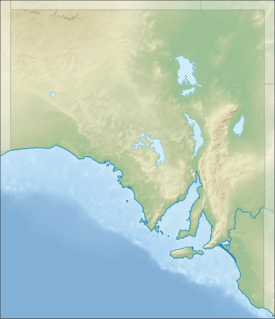Mount Taylor Conservation Park
| Mount Taylor Conservation Park South Australia | |
|---|---|
|
IUCN category III (natural monument or feature) | |
 Mount Taylor Conservation Park | |
| Nearest town or city | Vivonne Bay |
| Coordinates | 35°55′48.1″S 137°3′8.1″E / 35.930028°S 137.052250°ECoordinates: 35°55′48.1″S 137°3′8.1″E / 35.930028°S 137.052250°E |
| Established | 1 January 1970[1] |
| Area | 18 hectares (44 acres)[1] |
| Managing authorities | Department of Environment, Water and Natural Resources |
| See also | Protected areas of South Australia |
Mount Taylor Conservation Park is a protected area in South Australia which is located on Kangaroo Island. It was dedicated in 1970 primarily for the conservation of the rare triggerplant Stylidium tepperianum.[2]
Description
The conservation park has an area of 18 hectares (44 acres). It lies near the eastern end of Flinders Chase National Park, about 10 kilometres (6.2 mi) south-east of American River and 13 kilometres (8.1 mi)north-west of Vivonne Bay on the southern coast of the island. It encompasses Mount Taylor, a large rounded hill. The conservation park's vegetation is mostly an open scrubland and heath of Eucalyptus diversifolia, E. baxteri and E. cosmophylla, over Acacia myrtifolia and Pultenaea aceroa. It contains small patches of E. leucoxylon / E. cladocalyx woodland. Tepper’s Triggerplant occurs in the understorey.[2][3]
The conservation park is classified as an IUCN Category III protected area.[4]
See also
References
- 1 2 "Protected Areas Information System - reserve list (as of 16 July 2015)" (PDF). Department of Environment Water and Natural Resources. Retrieved 3 August 2015.
- 1 2 Anon (1987). Conservation Parks of Kangaroo Island Management Plan (PDF). Adelaide: Department of Environment and Planning, South Australia. ISBN 0-7243-8983-0.
- ↑ "Mount Taylor Conservation Park". Australian Heritage Database. Department of Sustainability, Environment, Water, Population and Communities, Australia. Retrieved 2012-09-23.
- ↑ "Terrestrial Protected Areas of South Australia (see 'DETAIL' tab)". CAPAD 2012. Australian Government - Department of the Environment. 2014. Retrieved 13 March 2015.